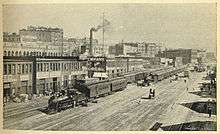Alaskan Way

Alaskan Way, originally Railroad Avenue, is a street in Seattle, Washington, that runs along the Elliott Bay waterfront from just north of S. Holgate Street in the Industrial District—south of which it becomes East Marginal Way S.— to Broad Street in Belltown—north of which is Myrtle Edwards Park and the Olympic Sculpture Park. The right-of-way continues northwest through the park, just west of the BNSF Railway mainline, and the roadway picks up again for a few blocks at Smith Cove.[1][2][3] It follows a route known in the late 19th century as the "Ram's Horn" (because of its shape).[4] Alaskan Way gives its name to the Alaskan Way Viaduct, which carries Washington State Route 99 through Downtown Seattle.
History

The idea of building a rail corridor along Seattle's Central Waterfront goes back at least to Thomas Burke and Daniel Hunt Gilman and the construction of the Seattle, Lake Shore and Eastern Railway in the years before the Great Seattle Fire of 1889.[5] Railroad Avenue was built as a planked roadway on pilings over the waters of Elliott Bay.[2][4] South of Downtown, the rail line constituted the one major man-made feature in an area of tideflats.[6]
The portion of Railroad Avenue from Yesler Way in what is now the Pioneer Square neighborhood to University Street near today's Harbor Steps burned in the Great Fire, as did most of the city and most of its piers. All were soon rebuilt on a grander scale. In the case of Railroad Avenue, this was largely the work of the Northern Pacific Railroad and Great Northern Railway.[2][4] The tideflats were steadily filled in, placing the rails south of Downtown—and the route of the southern portion of today's Alaskan Way—on dry land.[6]
Around 1900, Railroad Avenue was a chaos of horses and buggies, pedestrians, and rail cars, with multiple railroad tracks and sidings.[4] The congestion of the rail corridor was somewhat relieved when the Great Northern built a rail tunnel (1903–1906) under Downtown.[2] From that time, only traffic that actually needed to access the waterfront had to use Railroad Avenue; other trains could bypass the busy corridor. Still, there continued to be problems with the structural integrity of the planked roadway. Pilings had been driven into soft tideland substrates, waves caused continual damage, and railroad freight cars continually stressed the structure. Between 1911 and 1916, a concrete seawall strengthened the portion of the waterfront between S. Washington Street and Madison Street.[6]
Federal funds supplemented a local levy to allow the city to extend the seawall northward to Bay Street. The project was completed in 1936, and the extent of the seawall is the same as of 2008. Railroad Avenue was replaced by Alaskan Way, along the same route but built on landfill rather than on pilings.[6] In the early 1950s, the Alaskan Way Viaduct was built, paralleling Alaskan Way for much of its distance.
Notes
- ↑ Seattle Public Utilities City Property Finder
- 1 2 3 4 Paul Dorpat, Seattle Central Waterfront Tour, Part 6: From Railroad Avenue to Alaskan Way, HistoryLink, May 24, 2000. Accessed online 20 October 2008.
- ↑ Google Maps
- 1 2 3 4 Larson Anthropological Archaeological Services Limited 2004, p. 58 (p. 66 of PDF).
- ↑ Sale 1978, p. 64.
- 1 2 3 4 Larson Anthropological Archaeological Services Limited 2004, p. 59 (p. 67 of PDF).
References
- Sale, Roger (1978), Seattle, Past to Present: Past to Present, University of Washington Press, ISBN 0-295-95615-1
- Larson Anthropological Archaeological Services Limited (March 2004), "Appendix M: Archaeological Resources and Traditional Cultural Places Technical Memorandum" (PDF), Draft Environmental Impact Statement: SR 99: Alaskan Way Viaduct & Seawall Replacement Project, Parsons Brinckerhoff Quade & Douglas, Inc., retrieved 2008-10-20